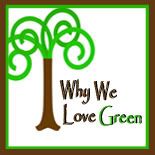The only downside is mythical: fruits and vegetables are just too expensive.
In all of my money-saving efforts, fruits and vegetables are never an area in which I skimp. The benefits are too wonderful to ignore and I have never felt like purchasing enough was breaking my bank.
 For the first money-saving tip on buying produce, I would like to direct you over to
For the first money-saving tip on buying produce, I would like to direct you over to Why We Love Green. Buying organic produce is more expensive than non-organic, so I encourage you to shop smart for your organic produce. Christine explains "the Dirty Dozen" in order to make buying organic more affordable.
Once you have decided which produce you will buy organically, focus on always comparing prices. Produce prices are ever-changing depending on the season, the quality of the produce, and sometimes "leaders" (which is when a company will lower a price to get you into the store but raise a price elsewhere to make up the difference).
My favorite produce items that are usually the cheapest year-round are:
- Cabbage (stay tuned for a whole post on the joys of cabbage!)
- Carrots, whole (never buy baby carrots, they are usually a waste of money)
- Onions
- Potatoes, sweet or russet
- Summer squash
- Apples (there is almost always a variety on sale, even in the off-season, usually Red Delicious)
- Bananas (the most popular "leader" produce)
These are the only fresh fruits and vegetables I purchase. Otherwise, I turn to the frozen aisle for:
- Corn
- Peas
- Spinach
- Broccoli
- Cauliflower
- Green beans
- Mixed vegetables (usually the cheapest option)
The last option is dried fruit. Even though they may not pack the same nutrients as fresh, they are great options for snacks, especially for children. I buy raisins and dried cranberries regularly in bulk at my local bulk foods store. Other dried fruits, such as blueberries, cherries, apples and prunes I will purchase if they are on sale.
The key is to compare prices and never get stuck in a produce-buying rut. Try new items if the price is right and get creative. Look for too-far-gone produce that is clearanced (usually apples, bananas and peaches) to use in baking. Spend a large amount of your grocery shopping time in the produce section looking for great deals and you will be amazed at the delicious variety you find.
Today, I challenge you to focus on eating five to eight servings of fruits and vegetables. Grab a handful of raisins at breakfast, throw some cabbage on your sandwich at lunch (its more nutrient-rich than lettuce with a delightful crunch!), and serve a veggie-rich summertime medley for dinner (try Herbed Pasta Primavera). No produce in the house? Then today, focus on researching some great produce-rich recipes and make a list of fruits and vegetables you would like to consume more of.
How do you focus on getting more fruits and vegetables into your diet?
Tomorrow: Tips on the cheapest and healthiest way to get your produce --- grow your own!

No comments:
Post a Comment